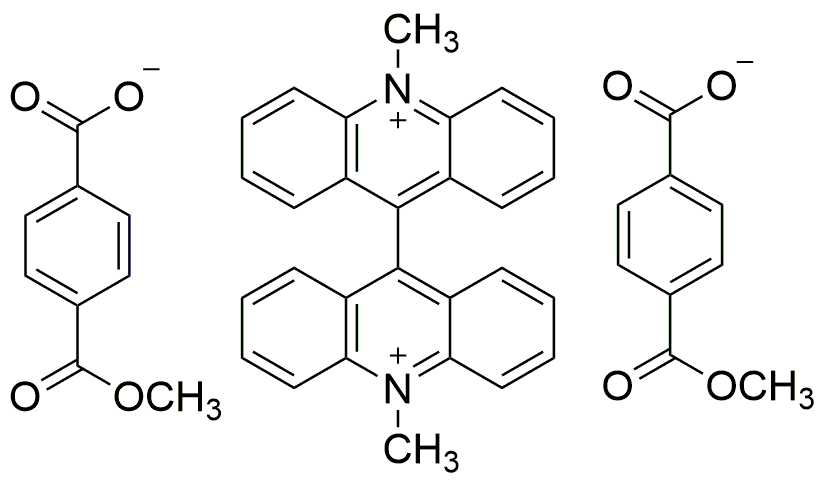10,10'-Dimethyl-9,9'-biacridinium bis(monomethyl terephthalate) is widely utilized in research focused on:
- Fluorescent Probes: This compound serves as a highly effective fluorescent probe in biological imaging, allowing researchers to visualize cellular processes with high specificity and sensitivity.
- Photodynamic Therapy: It is applied in photodynamic therapy for cancer treatment, where its ability to generate reactive oxygen species upon light activation helps in selectively targeting and destroying cancer cells.
- Electrochemical Sensors: The compound is used in the development of electrochemical sensors for detecting biomolecules, providing a reliable method for monitoring glucose levels or other important metabolites in clinical settings.
- Organic Light Emitting Diodes (OLEDs): Its unique electronic properties make it suitable for use in OLEDs, enhancing the efficiency and color quality of displays in electronic devices.
- Research in Material Science: The compound is explored for its potential in creating advanced materials with tailored optical and electronic properties, which can be beneficial in various industrial applications.
General Information
Properties
Safety and Regulations
Applications
10,10'-Dimethyl-9,9'-biacridinium bis(monomethyl terephthalate) is widely utilized in research focused on:
- Fluorescent Probes: This compound serves as a highly effective fluorescent probe in biological imaging, allowing researchers to visualize cellular processes with high specificity and sensitivity.
- Photodynamic Therapy: It is applied in photodynamic therapy for cancer treatment, where its ability to generate reactive oxygen species upon light activation helps in selectively targeting and destroying cancer cells.
- Electrochemical Sensors: The compound is used in the development of electrochemical sensors for detecting biomolecules, providing a reliable method for monitoring glucose levels or other important metabolites in clinical settings.
- Organic Light Emitting Diodes (OLEDs): Its unique electronic properties make it suitable for use in OLEDs, enhancing the efficiency and color quality of displays in electronic devices.
- Research in Material Science: The compound is explored for its potential in creating advanced materials with tailored optical and electronic properties, which can be beneficial in various industrial applications.
Documents
Safety Data Sheets (SDS)
The SDS provides comprehensive safety information on handling, storage, and disposal of the product.
Product Specification (PS)
The PS provides a comprehensive breakdown of the product’s properties, including chemical composition, physical state, purity, and storage requirements. It also details acceptable quality ranges and the product's intended applications.
Certificates of Analysis (COA)
Search for Certificates of Analysis (COA) by entering the products Lot Number. Lot and Batch Numbers can be found on a product’s label following the words ‘Lot’ or ‘Batch’.
Numéro de catalogue
Numéro de lot/série
Certificates Of Origin (COO)
This COO confirms the country where the product was manufactured, and also details the materials and components used in it and whether it is derived from natural, synthetic, or other specific sources. This certificate may be required for customs, trade, and regulatory compliance.
Numéro de catalogue
Numéro de lot/série
Safety Data Sheets (SDS)
The SDS provides comprehensive safety information on handling, storage, and disposal of the product.
DownloadProduct Specification (PS)
The PS provides a comprehensive breakdown of the product’s properties, including chemical composition, physical state, purity, and storage requirements. It also details acceptable quality ranges and the product's intended applications.
DownloadCertificates of Analysis (COA)
Search for Certificates of Analysis (COA) by entering the products Lot Number. Lot and Batch Numbers can be found on a product’s label following the words ‘Lot’ or ‘Batch’.
Numéro de catalogue
Numéro de lot/série
Certificates Of Origin (COO)
This COO confirms the country where the product was manufactured, and also details the materials and components used in it and whether it is derived from natural, synthetic, or other specific sources. This certificate may be required for customs, trade, and regulatory compliance.


